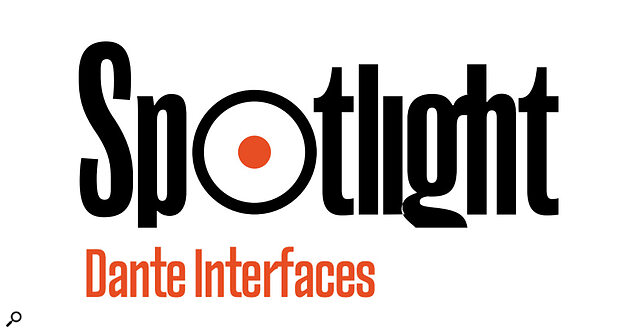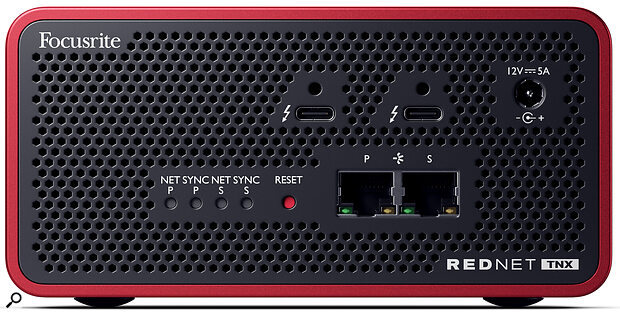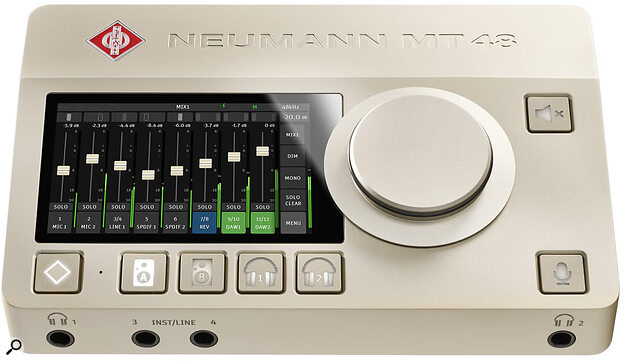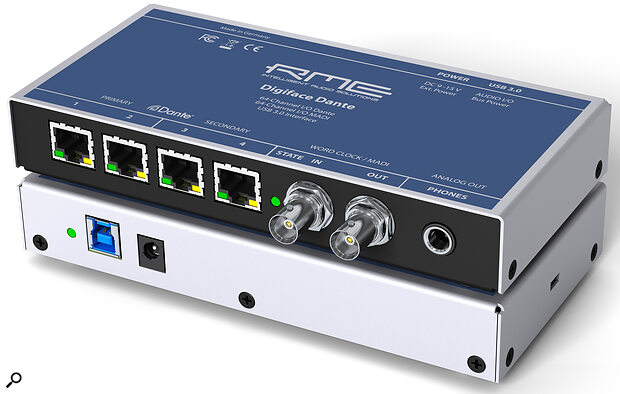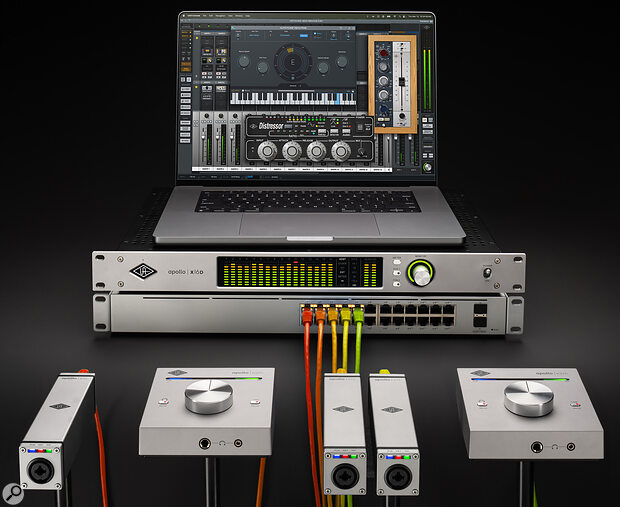Once the preserve of large studio facilities, Dante is now becoming common in smaller setups. We talk you through some of the options...
Since its introduction in 2006, Audinate’s Dante AoIP (Audio over IP) protocol has become hugely prevalent in the worlds of high-end live sound and broadcast. It’s easy to see the benefits for such applications: the ability to run over standard Ethernet networks, support for high channel counts and sample rates, being able to route input sources to multiple destinations, redundant backups that’ll help to avoid show-stopping failures, and so on. Those same benefits make Dante a compelling choice for large, multi-room commercial recording and post-production facilities, too, but there are now a growing number of products aimed at smaller studios.
Generally speaking, Dante interfaces fall into two categories: simple devices that offer a selection of Ethernet ports that can be used to connect your I/O devices of choice, and more traditional audio interfaces that feature their own selection of local I/O and use Dante connectivity as a means of expanding their channel count and integrating with other networked devices and systems. In this month’s Spotlight, we’ll be taking a look at a mixture of the two, but specifically those that are capable of passing audio between a DAW and Dante network via USB or Thunderbolt.
Avid MTRX Studio / MTRX II
Designed to bring the power of Avid’s large modular I/O systems to smaller spaces and budgets, the MTRX Studio is a 1U unit that includes 64 channels of Dante connectivity alongside 18 analogue mic and line-level connections, 64 DigiLink channels and 16 ADAT channels. Connectivity with Pro Tools HDX systems is complemented by an optional Thunderbolt 3 card that allows for a native connection to Macs and PCs, and comprehensive routing functionality via DAD’s DADman software application makes it possible to pass audio from any input to any output, allowing users to share connectivity across multiple devices and different DAWs simultaneously. There’s built-in support for monitoring Dolby Atmos in layouts up to 9.1.6, and EuCon integration means that the interface’s monitoring functions can be controlled directly from Avid control surfaces. Its larger sibling, the MTRX II, then offers a modular platform that supports 256 Dante channels in its standard form (along with 64 DigiLink and MADI channels), and can be expanded to accommodate a massive 1280 channels that can be distributed to multiple audio networks — even if they’re running different sample rates and sync’ing to different clocks.
MTRX Studio (Thunderbolt) £5229, MTRX II from £8263.80. Prices include VAT.
MTRX Studio (Thunderbolt) $5798, MTRX II from $7798.
DAD AX Center / AX64 / Core 256
The newest addition to Digital Audio Denmark’s Thunder Core family packs a huge amount of connectivity into a compact 1U unit — fully expanded, the AX Center boasts a whopping 984 inputs and outputs! In its standard form, it supports 256 channels of Dante alongside 64 channels of MADI, 16 channels of ADAT, as well as featuring a pair of mic/instrument inputs and eight analogue outputs (two stereo monitor pairs and two stereo headphone outputs); the unit’s Thunderbolt 3 connection is capable of carrying 256 inputs and outputs to/from a host computer. A pair of expansion slots make it possible to add yet more I/O, with options including analogue mic pres and line-level I/O, AES, MADI and yet more Dante — with the appropriate cards installed, the total Dante I/O count tops out at 512.
If that’s not enough, then its larger sibling, the AX64, includes eight expansion slots and supports a staggering 1872 input and output channels! Finally, there’s the Core 256, a digital-only interface that features 256 channels of Dante and 64 channels of MADI, and has been designed with live sound and post-production duties in mind. Routing and monitoring control for all three interfaces is taken care of by the company’s DADman application.
AX Center £4284, AX64 £4830, Core 256 £3162. Prices include VAT.
AX Center $4099, AX 64 $5099, Core 256 $3099.
Focusrite Red 8Line/16Line
Focusrite’s RedNet range includes a versatile selection of interfaces, converters and monitoring controllers that all feature Dante connectivity, catering to everything from compact studio and live recording rigs to modular, scalable systems for large, multi-room facilities. The Red 8Line is a 1U unit that, as its name suggests, features eight analogue line-level inputs and outputs, along with 16 channels of ADAT I/O, stereo S/PDIF connectivity, a pair of the company’s Red Evolution mic preamps, two high-impedance instrument inputs and 32 channels of Dante. The Red 16Line then increases the local analogue line-level I/O count from eight to 16. Both units can be hooked up to Pro Tools HDX systems thanks to DigiLink ports, while native Mac and PC connectivity is provided over Thunderbolt 3.
Red 8Line £2729.99, Red 16Line £3649.99. Prices include VAT.
Red 8Line $3699.99, Red 16Line $4499.99.
Focusrite RedNet TNX
The latest addition to the RedNet line-up offers a Thunderbolt-equipped alternative to their PCIeNX card, bringing high-channel-count Dante connectivity to laptops and desktop users with no spare PCIe slots. Out of the box, it’ll support 128 inputs and 128 outputs to/from a Dante network at 192kHz, and that count can be doubled to a whopping 256x256 channels by purchasing an optional software upgrade from Audinate’s Dante Activator software — when running in 256x256 mode, the maximum sample rate is 96kHz. Connection to a host computer is handled via Thunderbolt 3, and a pair of rear-panel ports that each provide 15W of power make it possible to run the RedNet TNX alongside other Thunderbolt devices. Dante connectivity is taken care of by two Ethernet ports that can be configured to operate in switched or redundant modes; with the former, the TNX will act as a network switch, allowing it to be daisy-chained with other Dante devices, while the latter can be used to create a redundant backup system. Drivers are available for both Mac and Windows systems, with all of the device’s routing and monitoring functionality handled by Focusrite’s RedNet Control software.
£1899.99 including VAT.
$2199.99.
Neumann MT 48
While the MT 48 was originally designed to support RAVENNA and AES67 networked audio, Neumann say that their users requested a version that would be compatible with Dante. From the end of 2024 onwards, the MT 48 has been shipped with a Dante Ready sticker on its packaging. By default, it still comes loaded with the original firmware, but those who wish to add Dante connectivity can do so by installing a free firmware update from Neumann, and purchasing the appropriate licence from Audinate — there are 8x8- and 64x64-channel options available. With the appropriate firmware and licence installed, the MT 48’s Ethernet port can be used to connect the interface to a Dante network, expanding its built-in I/O with up to 64 channels of Dante inputs and outputs. Local connections include a pair of built-in mic/line inputs and four line-level outputs, along with ADAT I/O and a pair of quarter-inch TRS sockets that can function either as MIDI or GPIO ports. Connectivity to a host computer is provided by a USB-C socket.
RME Digiface Dante
RME’s Digiface range includes five simple interfaces that cater to the most commonly used digital and AoIP formats. The Digiface Dante packs in 64 channels of Dante and 64 channels of MADI I/O, offering a massive 256 channels of audio over USB 3.0. Dante connectivity is provided by four gigabit Ethernet sockets (two Primary and two Secondary), while a pair of BNC connectors can be configured either as word-clock or MADI I/O. As well as serving as inputs and outputs, the dual Primary and Secondary Dante ports allow the interface to function as a network switch, and also make it possible to set up a redundant secondary network for some peace of mind in mission-critical applications. Despite the focus on digital formats, the Digiface Dante is equipped with a quarter-inch TRS socket that can function either as a headphone output or a stereo line-level analogue output. Signal routing and mixing is carried out by RME’s renowned TotalMix software, although the lack of DSP in the Digiface line-up means that the range of built-in effects and processors included in TotalMix FX are not available. In addition to its primary function as a USB audio interface, the Digiface Dante is capable of acting as a standalone 64-channel Dante/MADI converter.
Universal Audio Apollo x16D
Designed with both live sound and studio applications in mind, the Apollo x16D combines Universal Audio’s renowned DSP-based UAD plug-ins with the flexible routing and redundancy options provided by AoIP networking. For live applications, the interface offers a convenient way to integrate UAD plug-ins into a live console running on a Dante network, while studio users benefit from the ability to easily set up a multi-room Apollo-based system over a standard network. The latest addition to the Apollo line-up complements the standard Apollo x16’s connectivity with 16 Dante inputs and outputs, and it’s possible to link up to four units for a maximum of 64 channels of Dante I/O at sample rates up to 96kHz. Monitoring options cover everything from stereo to a variety of immersive formats (Dolby Atmos, Auro-3D, Sony 360 Reality Audio) in layouts up to 9.1.6, with built-in room-correction facilities provided by Sonarworks integration. The Apollo x16D can be purchased in two versions: Essentials+ and Ultimate+, which come bundled with 33 and 124 UAD plug-ins/four LUNA Extensions respectively.
Apollo x16D Essentials+ £2797, Ultimate+ £3715. Prices include VAT.
Apollo x16D Essentials+ $2999, Ultimate+ $3999.
Dante Virtual Soundcard
An alternative to a hardware interface comes in the form of Audinate’s Dante Virtual Soundcard application. As its name suggests, the software allows an Ethernet-equipped Mac or PC to appear as an audio interface on a Dante network, making it possible to route audio between computer applications and any connected hardware devices. Two variants are available: Standard and Pro, both with a selection of licensing options — Standard can be rented for 30 days or bought as a perpetual licence, Pro is available either as an annual subscription or on a fixed-term licence. The key distinction between the two is channel count: Standard will accommodate up to 64 inputs and outputs at 44.1/48 kHz (falling to 32x32 at 88.2/96 kHz and 8x8 at 176.4/192 kHz), while Pro offers 128x128 operation at sample rates up to 96kHz, and 16x16 at 176.4/192 kHz. Because the necessary processing takes place on the host computer, DVS does incur higher latency than opting for a hardware interface, although for situations that don’t require real-time monitoring — capturing a live performance from or offering playback for a virtual soundcheck on a Dante-equipped console, for example — it can offer a neat, cost-effective solution.
- Standard 30-Day: $19.99.
- Standard Single Machine: $49.99.
- Standard Transferable: $99.99.
- Pro Annual: $124.99 per year.
- Pro Term: 1-Year $124.99, 3-Year $299.99.

